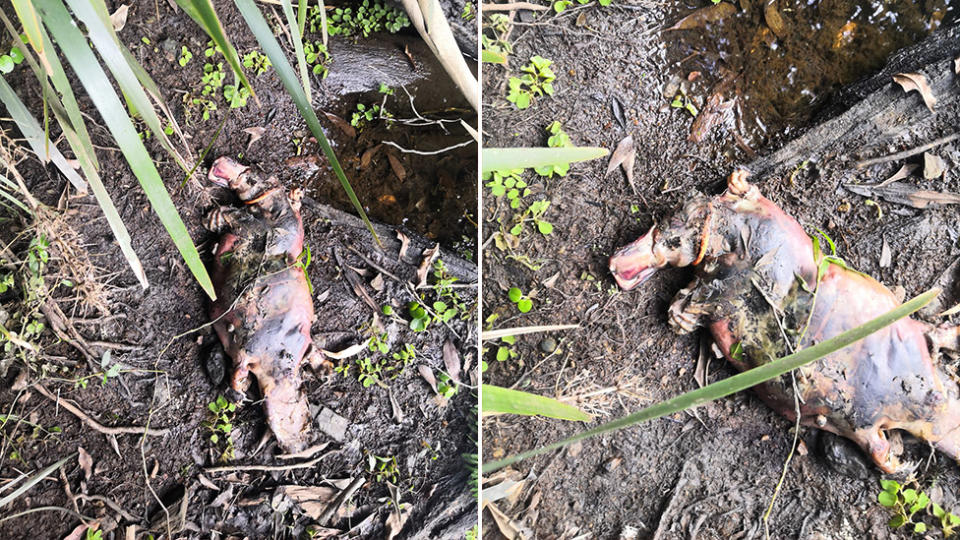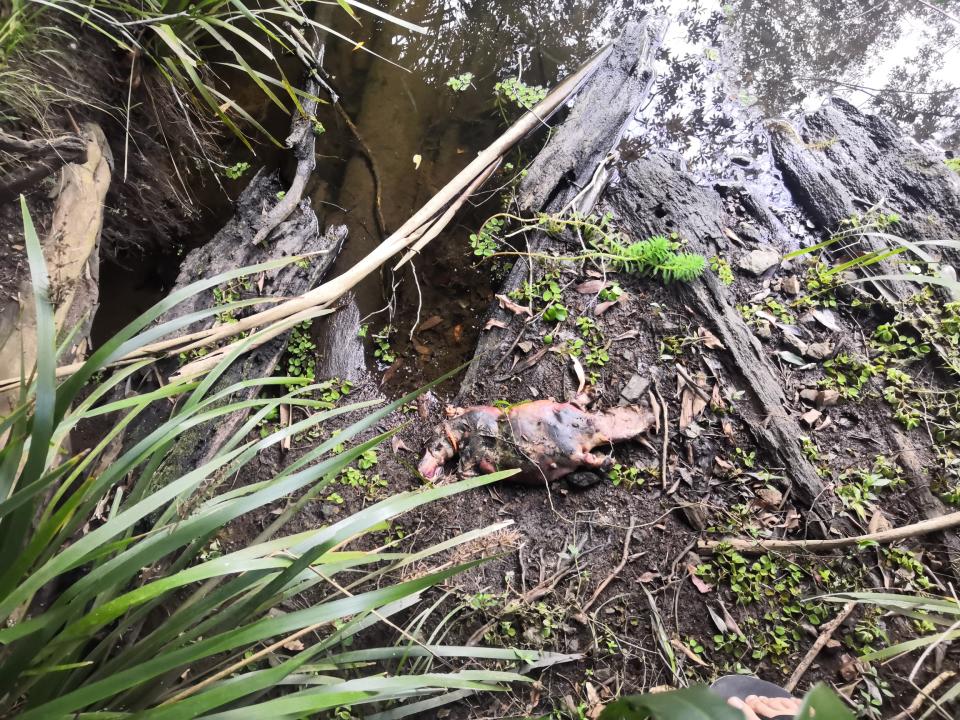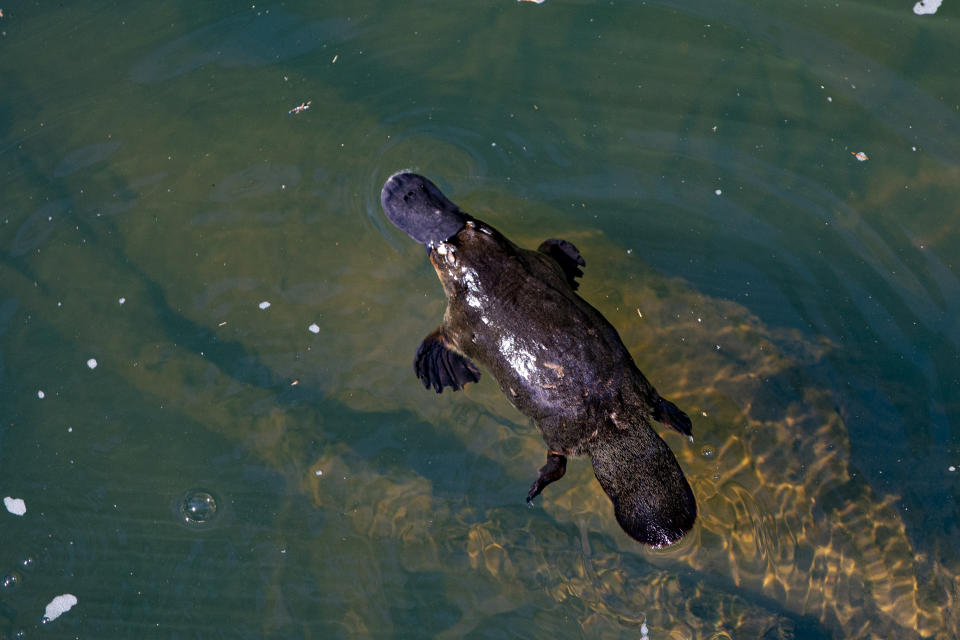Troubling platypus photo shows 'peculiar' danger of popular accessory
WARNING – GRAPHIC CONTENT: While on a picturesque walking trail, two men stumbled upon the corpse of a beloved Australian mammal, which serves as a bleak reminder for how human actions have consequences.
Todd Dent and Javier Pastor de Frutos were walking along the Wappa Falls trail on Queensland’s Sunshine Coast.
Mr Dent lives just minutes down the road from the trail, while Mr Pastor de Frutos hails from Spain and came to study in Australia, guided by his love for animals.
On their walk they came across a dead platypus, with what Mr Dent described as some sort of hair tie around its neck.

“We just decided to get out of the house and go down for a bit of nature,” Mr Dent told Yahoo News Australia.
“Upon walking down to a different spot, I saw it [the platypus] down there. Wappa Falls is quite a nice place, but the bit that does deter me from there is a lot of people do leave rubbish.”
Mr Dent speculates people who use the area may not be aware of how rubbish left behind can impact on wildlife. He says some of the rubbish he has seen at Wappa Falls does not appear to be left there accidentally.
He says having no bin facilities there is “disappointing for the attraction it gets”.
'It's devastating': Concern for threatened animal amid state's trapping plan
'Shredded': Call for rethink of barbed wire fencing after horrendous deaths
The battle to save Australia's dying koalas continues amid coronavirus crisis
In a statement to Yahoo News Australia, a spokesperson from Queensland’s Department of Environment and Science (DES) confirmed there were no bins at Wappa Falls.
“Bins are not provided at Wappa Falls, consistent with a department-wide approach. Rubbish bins become a collection point for scraps, attracting wild animals and putting them at risk,” the spokesperson said.
“Wild animals that feed regularly on food scraps can become habituated and potentially lose their drive to forage for their own food.
“Visitors to our parks are urged to take all rubbish with them when they leave so our native wildlife are kept safe and our natural environments are kept clean.”

‘Sad but timely reminder’ litter harms wildlife
Mr Dent was naturally quite upset to find the dead platypus. But despite the disturbing images, he hopes something good can come out of it.
“They [platypuses] are so rare now, and to find one that had died like that, in a place like that, this is the wake-up call we need for this problem to be dealt with,” he said.
“I spied it, and Javier loves his flora and fauna and I was like, ‘Look, mate, it’s probably not the way you want to see the platypus but here is a platypus’, so he came over [and had a look].”
Mr Pastor de Frutos has been in Australia for just a few months, coming here on a student visa to study English.
“It was very bad because I love animals,” Mr Pastor de Frutos told Yahoo News Australia.
“It’s one of the reasons I come here to Australia.
“This animal that is very strange [the platypus], I didn’t like to see that.”
The discovery prompted Mr Pastor de Frutos to share the photos to Facebook.
“This is what happens when you leave some garbage anywhere and think it doesn't matter, for a little bit nothing happens,” he wrote.
The comments were inundated with people expressing their anger, exclaiming this is why people need to take care of their rubbish.
“The death of a platypus at Wappa Falls is a sad but timely reminder that litter in our environment can kill our native wildlife,” the DES spokesperson told Yahoo News Australia.

‘Peculiar’ threat to platypuses
Mr Dent and Mr Pastor de Frutos believe it was a hair tie caught around the platypus’s neck that claimed the animal’s life.
Australian Platypus Conservancy biologist Geoff Williams said hair ties were one of the three major threats to the mammals.
The three categories of litter which pose the biggest threat to platypus populations are plastic rings of any sort, fishing line and, something Mr Williams describes as “peculiar”, elasticated hair ties.
While hair ties are extremely easy to lose, Mr Williams explains this is a growing problem.
A few months back he started picking up hair ties when he saw them on the ground and in less than a month he had collected about 20.
Researchers spot giant feral cat carrying dead goanna in outback
Invasive pest or Aussie heritage? Debate rages as brumby slaughter looms
“They get dropped in all sorts of places and washed down into the creeks,” Mr Williams told Yahoo News Australia.
The DES spokesperson said the way platypuses look for food made hair ties a major threat to them.
“While the platypus is not an endangered or threatened species, elastic and plastic bands are a particular risk because of the way they forage along the bottom of riverbeds using their bills to scoop up food,” the DES spokesperson said.
Mr Williams said platypuses getting entangled in trash was a big issue and one where the full extent was not known, adding mortality factors were somewhat mysterious.
The Australian Platypus Conservancy recommends contacting the organisation if you come across a dead platypus, which could greatly assist biologists and wildlife veterinarians.

Mr Williams explained platypuses are not endangered, however they are classified as “near threatened”.
“It’s regarded as ‘near threatened’ because there is evidence platypus populations have declined significantly in some areas and the causes of that decline are still continuing in many places,” he told Yahoo News Australia.
However in some parts of Australia, populations are doing quite well, despite dwindling numbers in some parts of the country.
“We argue, that the way to look at platypuses is not at a cross-the-board look at their numbers, the way they should be regarded is by a catchment-by-catchment basis,” Mr Williams explained, adding platypuses could not move from place to place easily.
“If they go extinct in one catchment that’s it.”
In the May edition of the Newsletter of the Australian Platypus Conservancy, it is highlighted why platypuses are one of the “most distinct mammals” in the world.
“It has no really close relatives, and is one of just five species to be classified as monotremes, or egg-laying mammals,” the newsletter says.
“Its largely unshared evolutionary history means that the platypus also has many odd physical features as compared to most other mammals.”
Do you have a story tip? Email: newsroomau@yahoonews.com.
You can also follow us on Facebook, Instagram and Twitter and download the Yahoo News app from the App Store or Google Play.



